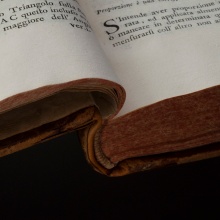Writings on architecture have been collected at the University and its predecessor institutions since the foundation of the Royal Polytechnic School in 1840. They were among the most important foundations of architectural education and conveyed traditional knowledge about the art of building as well as the most current findings and discourses. Even in the early annual reports and library catalogs of the University, there is evidence of correspondingly large stocks of architectural books, including old and rare editions. They were kept and used not only at the central University Library, but also at the individual architecture departments; the Institute for Building History and Building Design, founded in 1911, also had its own teaching collection and library. After heavy losses during the war, it was again able to gain extensive and in part valuable new acquisitions through purchases and donations after 1945. Volumes particularly worthy of protection remained at the institute even after 1994 when the holdings were absorbed into the newly established Faculty of Architecture and Urban Planning Library.
Today, the ifag holds approximately 200 original editions and high-quality facsimiles, representing a crosssection of the most important European architectural discourses from the Renaissance to modernity. Special treasures include early editions and first German translations of seminal treatises by Sebastiano Serlio (1475-c. 1554), Guarino Guarini (1624-1683), and Johann Bernhard Fischer von Erlach (1656-1723). Another focus is on publications on classicist architecture and early preservation of historical monuments from the 18th and 19th centuries, reflecting the University's early teaching activities.
In cooperation with the University Library, 24 selected volumes of the collection were processed as part of a seminar project and made digitally accessible to the public in an online exhibition in 2021.
Contact:
Institute of Architectural History



